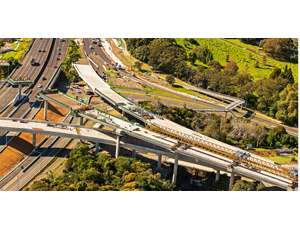

Work has resumed on a key element of the billion-dollar Waterview Connection highway project in Auckland, following delivery of substandard concrete in April that stopped construction, says the New Zealand Transport Agency. The error required repairs on a large interchange, but managers of New Zealand’s largest infrastructure project say it won’t affect overall job schedule.
A production fault at an Auckland batch plant operated by Firth Concrete—owned by Fletcher Building, one of New Zealand’s largest public companies—resulted in some 70 projects receiving some flawed concrete. These included a new science building at the University of Auckland, which required some repair, according to the New Zealand Herald.
Firth general manager Andrew Moss said investigations indicate that faulty measuring equipment at the site led to low cement content in the mixes and caused the problem. The plant has since reopened after repairs.
Most affected is a 500-m long, 23-m-high elevated section of the highway that forms part of the city's Great North Road Interchange, which is the longest and highest of the four motorway-to-motorway access-egress ramps on the Waterview Connection project. The agency says the structure is on schedule to finish by year’s end. Replacement of faulty concrete delivered to the site will not delay completion.
Agency highways manager Brett Gliddon said work was resumed after detailed investigations showed there was no threat to safety or quality of future works. “The faulty concrete is not located on sections of the ramp spanning the motorway or the existing interchange,” he said.
Night work on the interchange resumed on May 20 to place 11 Super T beams, each weighing between 55 and 65 tonnes, on two spans of the ramp. “There is no relaxation of safety or design standards,” Gliddon said. “The lifting gantry’s load is taken by other sections of the ramp that are fully compliant with strength and durability requirements. There will be additional strength from the temporary support structures we have in place during our big concrete pours on the interchange; they are still there.”
Defective concrete will be removed from a section of the deck that forms the surface for traffic lanes on the ramp. The final repairs to the affected portal or cross beam will be completed once all 77 super beams for the ramp have been lifted into place at the end of the year, says Gliddon, adding that project completion remains on track for early 2017.
Elsewhere on the project, full tunnelling has resumed on a second tunnel that will carry three lanes of northbound traffic after the Herrenknecht-manufactured tunnel boring machine—the largest ever used in the Southern Hemisphere, according to officials—was rotated 180 deg earlier this year. Breakthrough at the northern tunnel terminus is set for mid-autumn.
Backfill operations in the first excavated tunnel are almost complete, and excavation has begun of the first of 17 cross passages that will link the two tunnels every 150m.
The project’s pre-cast factory yard will complete this month production of the 24,000 concrete segments needed to line the tunnels.
The Waterview Connection project involves construction of 4.8 km of a six-lane highway to finish Auckland’s Western Ring Route and provide an alternative through the central city.
It is being delivered through a joint venture called the Well-Connected Alliance that includes the transit agency, Fletcher Construction, McConnell Dowell, Obayashi, PB New Zealand, Beca and Tonkin & Taylor.

Post a comment to this article
Report Abusive Comment